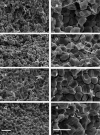Reduced Contraction of Blood Clots in Venous Thromboembolism Is a Potential Thrombogenic and Embologenic Mechanism
- PMID: 31249934
- PMCID: PMC6524864
- DOI: 10.1055/s-0038-1635572
Reduced Contraction of Blood Clots in Venous Thromboembolism Is a Potential Thrombogenic and Embologenic Mechanism
Abstract
Contraction (retraction) of the blood clot is a part of the clotting process driven by activated platelets attached to fibrin that can potentially modulate the obstructiveness and integrity of thrombi. The aim of this work was to reveal the pathogenic importance of contraction of clots and thrombi in venous thromboembolism (VTE). We investigated the kinetics of clot contraction in the blood of 55 patients with VTE. In addition, we studied the ultrastructure of ex vivo venous thrombi as well as the morphology and functionality of isolated platelets. Thrombi from VTE patients contained compressed polyhedral erythrocytes, a marker for clot contraction in vivo. The extent and rate of contraction were reduced by twofold in clots from the blood of VTE patients compared with healthy controls. The contraction of clots from the blood of patients with pulmonary embolism was significantly impaired compared with that of those with isolated venous thrombosis, suggesting that less compacted thrombi are prone to embolization. The reduced ability of clots to contract correlated with continuous platelet activation followed by their partial refractoriness. Morphologically, 75% of platelets from VTE patients were spontaneously activated (with filopodia) compared with only 21% from healthy controls. At the same time, platelets from VTE patients showed a 1.4-fold reduction in activation markers expressed in response to chemical activation when compared with healthy individuals. The results obtained suggest that the impaired contraction of thrombi is an underappreciated pathogenic mechanism in VTE that may regulate the obstructiveness and embologenicity of venous thrombi.
Keywords: blood clotting; clot contraction; clot retraction; thrombosis; venous thromboembolism.
Conflict of interest statement
Figures






Similar articles
-
Blood clot contraction: Mechanisms, pathophysiology, and disease.Res Pract Thromb Haemost. 2022 Dec 23;7(1):100023. doi: 10.1016/j.rpth.2022.100023. eCollection 2023 Jan. Res Pract Thromb Haemost. 2022. PMID: 36760777 Free PMC article.
-
Extent of intravital contraction of arterial and venous thrombi and pulmonary emboli.Blood Adv. 2022 Mar 22;6(6):1708-1718. doi: 10.1182/bloodadvances.2021005801. Blood Adv. 2022. PMID: 34972200 Free PMC article.
-
Impaired contraction of blood clots as a novel prothrombotic mechanism in systemic lupus erythematosus.Clin Sci (Lond). 2018 Jan 19;132(2):243-254. doi: 10.1042/CS20171510. Print 2018 Jan 31. Clin Sci (Lond). 2018. PMID: 29295895
-
Venous and Arterial Thromboses: Two Sides of the Same Coin?Semin Thromb Hemost. 2018 Apr;44(3):239-248. doi: 10.1055/s-0037-1607202. Epub 2017 Sep 25. Semin Thromb Hemost. 2018. PMID: 28946150 Review.
-
Plasma fibrin clot structure and thromboembolism: clinical implications.Pol Arch Intern Med. 2017 Dec 22;127(12):873-881. doi: 10.20452/pamw.4165. Epub 2017 Dec 11. Pol Arch Intern Med. 2017. PMID: 29225327 Review.
Cited by
-
Impaired contraction of blood clots precedes and predicts postoperative venous thromboembolism.Sci Rep. 2020 Oct 26;10(1):18261. doi: 10.1038/s41598-020-75234-y. Sci Rep. 2020. PMID: 33106547 Free PMC article.
-
A familial case of MYH9 gene mutation associated with multiple functional and structural platelet abnormalities.Sci Rep. 2022 Nov 20;12(1):19975. doi: 10.1038/s41598-022-24098-5. Sci Rep. 2022. PMID: 36404341 Free PMC article.
-
Red blood cells: the forgotten player in hemostasis and thrombosis.J Thromb Haemost. 2019 Feb;17(2):271-282. doi: 10.1111/jth.14360. Epub 2019 Jan 7. J Thromb Haemost. 2019. PMID: 30618125 Free PMC article. Review.
-
Differential sensitivity of various markers of platelet activation with adenosine diphosphate.Bionanoscience. 2019 Mar;9(1):53-58. Epub 2018 Dec 10. Bionanoscience. 2019. PMID: 31534882 Free PMC article.
-
Accelerated Spatial Fibrin Growth and Impaired Contraction of Blood Clots in Patients with Rheumatoid Arthritis.Int J Mol Sci. 2020 Dec 11;21(24):9434. doi: 10.3390/ijms21249434. Int J Mol Sci. 2020. PMID: 33322373 Free PMC article.
References
Grants and funding
LinkOut - more resources
Full Text Sources

